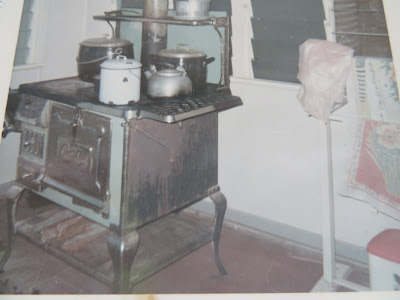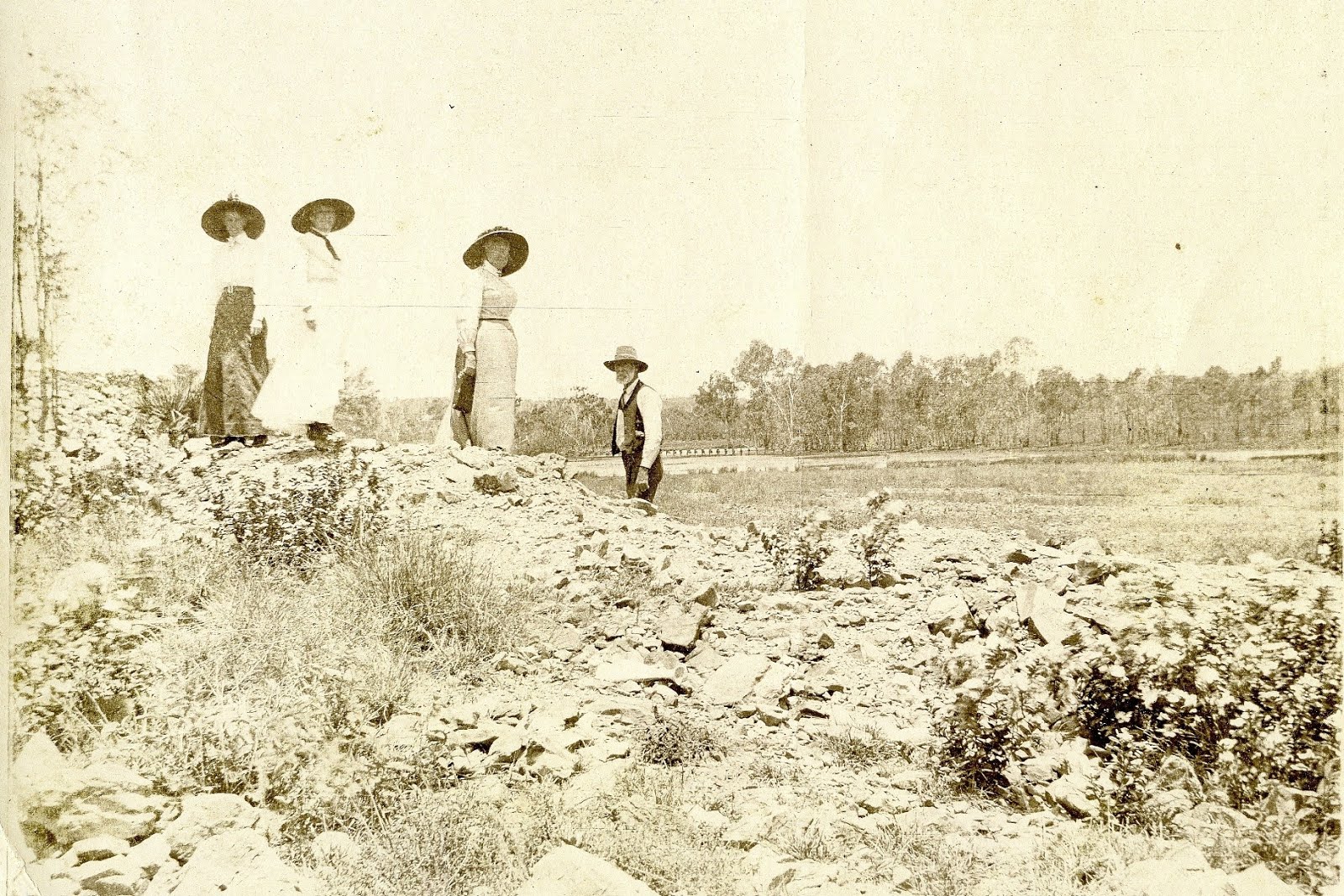Sunday 17 December 2017
THE YOUNG STOCKMAN
Tuesday 12 December 2017
LIFE ON A CATTLE STATION
Monday 4 December 2017
FACES FROM ACROSS THE AGES
For many years, these photographs had the wrong names attributed to them and the wrong time period. I can now safely say who they were.
One is of John Clark, my great grandfather and the other is his first wife, Jane Farrell. At the time they were living in Bowen, Queensland and must have been in Sydney visiting family.
Wednesday 29 November 2017
THE OLD CATTLE STATION.
 |
| Upstairs verandah with father's gun cupboard and my bed. |
 |
| The wood stove. Great to be around on a cold morning. |
 |
| The lounge. A few parties in here. |
 |
| Downstairs. It was the coolest part of the house. There were no fans or air-conditioners then. |
 |
| Dad in the kitchen. |
 |
| Rain water tank. |
 |
| A bedroom. Note the pistol hanging off the bed. |
Monday 3 July 2017
THE SPORT OF KINGS AND FAMILY. PART TWO.
 |
| Precocious in front, 1933 Grand National. Photo: jumps heroes of yesterday. |
My father’s first cousin, Simon Lynch became a jockey mainly
competing in steeple chase events in Melbourne. Simon’s greatest racing triumph was riding the winner,
Precocious, in the 1932 Grand National Steeplechase at Flemington, Melbourne.
The Grand National is Australia’s most prestigious steeple chase race and Flemington
is Australia’s most prestigious race course. The events surrounding this win were highly controversial, and history making.
Precocious was owned and trained by twenty-two year old, Miss Dorothy
Shiel. Since World War One, women had been permitted to nominate themselves as
horse owners. This entitled them to train their own horses without first
obtaining permission from the Victoria Racing Club. This is what Miss Shiel had
done with Precocious.
When she won the Grand National, Dorothy became the first
female trainer to win a race at Flemington. Although the win was very popular
with the public, the V.R.C committee refused to allow her into the mounting yard
to accept the trophy. A few days later, the V.R.C committee advised that owners
henceforth would need to obtain a permit to train their own horses, and that
such permits would not be granted to women.
The Chairman of the V.R.C, Mr L.J.S. MacKinnon declared, ‘horse
training was not suitable for women. The engagement of jockeys and other duties
connected with training were essentially jobs for men- simply it was not
thought to be women's proper sphere.' The restrictive measures were not lifted
until the early 1970's.
Tragically, Simon was killed at age twenty-five on the 2nd May 1935,
at Flemington while schooling a horse.
Sunday 25 June 2017
THE SPORT OF KINGS AND FAMILY
 |
| My uncle, Jack Bell,as an amateur jockey. |
The Bells and the Clarks were devotees of the sport of
kings. Describing them as
devotees is too mild; they treated horse racing as a religion. They would have
gladly raced horses full time rather than run cattle stations.
I think I’m the only one of my family that never owned a
race horse. Even my father raced a horse
and he once told me that the racing fraternity were the lowest form of human
life. My father and all of his seven siblings (three females and four males) owned
horses. Then it was my grandparents,
Jane Florence and Richard Bell who raced horses, largely in North Queensland.
My grandfather had an unfortunate incident with one of his
purchases from Melbourne. The stallion
had raced in several major races in Melbourne including an unplaced in the
Melbourne Cup. On its arrival in Charters Towers from Melbourne, he was showing
it off down the main street when it grabbed him by the seat of the pants,
lifted him up and dumped him in on the ground. The resulting injury was enough to put him in hospital.
My grandfather still kept the horse and it lived a long life.
My great grandfather, John Clark, regularly attended the
Sydney and Melbourne yearling sales and raced winners in North Queensland. My grandfather’s brothers and cousins were
also heavily involved in the racing industry as owners, jockeys, farriers and
stewards. It even goes down to the
present day when my father’s first cousin, Doctor Kevin Bell (Veterinary Science),
founded the Australian Equine Genetic
Research Centre in 1986. It is located at the University of Queensland in
Brisbane.
Some of the most notable family horses and racing wins are:
Grosvenor Downs ( owned by Minnie and Cosmo Gordon. Minnie
was a sister of my grandmother) owned My
Man who was a grandson of Assyrian. Assyrian won the 1882 Melbourne Cup. They
also owned Nonette who was bought as a breeding sire. During his racing career,
Nonette won the equivalent of seven million dollars in today’s money.
My grandfather’s brother, John Bell, who owned Cardigan
Station, bought Eastcourt as a breeding sire.
During Eastcourt’s career he won the equivalent of five million dollars
in today’s money. Some of his wins are the VRC Handicap and the Sydney Tattersalls.
Eastcourt also ran second in the Sydney Cup and a third in the VRC Derby and
the Australian Cup.
 |
| Eastcourt. |
A first cousin of my father named Simon Lynch, won the Grand
National Steeplechase in Victoria in 1932.
As you can see, horse racing is in the blood.
Monday 19 June 2017
THE BLOODY FRONTIER
http://www.australianfrontierconflicts.com.au/index.php/conflicts/chronology/qld
I have been looking at the above website which details the list of massacres of Indigenous Australians in my home state of Queensland. Many are focused from 1860 onward in the northern region of the state which is where I was born and raised. It's a sobering and heart- breaking read.
If you don't know much about Australian history, Indigenous Australians were locked in conflict with Europeans soon after settlement in 1788. It is estimated that the pre-1788 population of the Indigenous people across Australia was between 500,000 to 750,000. At the start of the twentieth century, the population had been markedly reduced to about 93,000 due to European diseases, massacres and conflict.
Why I took particular interest in this website, is that it mentions the cattle station of Grosvenor Downs as an area of conflict in 1868. No details are mentioned.
I knew that Grosvenor Downs belonged to my great grandfather, John Clark and prior to that his half-sister, Isabella Clark and her husband, Alexander McDonald. John Clark later gave the station to his daughter as a wedding present.
I was hoping that my family weren't involved in such a heinous crime. Further research indicated that in 1868 a Frank Bridgman owned the cattle station. It was sadly a massacre of local Indigenous people; sixty in total. No reason is given why this massacre occurred. I can only surmise that a European or cattle were speared causing the settlers to retaliate.
Sadly, it was not an isolated incident. The list of conflicts between Indigenous people and Europeans in Queensland goes right up to 1929.
It is history that was conveniently overlooked. I don't think that should be the case anymore.
Tuesday 30 May 2017
HOW TO MAKE AN ENTRY
 |
| Thomas James Bell. |
Here's another story about my wild great uncle, T.J. Bell. T.J. was staying at the Queens Hotel in the early part of
the twentieth century. The Queens Hotel was located in Townsville, Queensland.
It was the grandest hotel in the north, the place to stay for dignitaries and
graziers who were the power elite of the time. It was the snob centre of town.
 |
| Queen's Hotel, Townsville. Foyer entry is to left of photo. Photograph from Townsville City Libraries. |
So it all probably started with T.J. getting into an extended
drinking bout with his cronies then a bet. It progressively went downhill from
there. The dare was to bring a four in
hand carriage into the front foyer of the Queen’s Hotel. A four in hand is a
carriage drawn by four horses positioned with two at the front and two behind.
Well, you have to admire T.J.’s pluck because he nearly did
it. He did manage to get the two front horses into the foyer before being
stopped by irate hotel staff. I’m not
sure if he won the bet or got permanently banned from the hotel.
Sunday 21 May 2017
CATTLE DUFFING
Just to set things right, we call it cattle duffing in the outback
not cattle rustling. Cattle duffing is regarded
as Australia’s second oldest industry. I’ll
let you figure out which is the oldest.
Cattle duffing is still as relevant today as it was in the wild
colonial days. In fact, it is on the rise in rural Australia despite the fact
that it is harder to steal cattle now then one hundred years ago. The Australian state of Queensland has a police
unit specifically devoted to stock theft which is aptly titled, The Stock
Squad.
Apparently, ice-addicts in rural towns are duffing livestock
from farms in their desperate desire to fund their addiction. I read one recent
story about a grazier who left his cattle station for a week to attend a
wedding and returned to find that nearly one million dollars of his live stock
had been stolen. At one thousand dollars a head, cattle duffing is seen as a
lucrative criminal activity.
My father once told me that Uncle Jack and he were once
boundary riding around our station when they caught the next door neighbours
helping themselves to our cattle. Uncle Jack and dad blew their stacks and
actually pulled rifles on them. Uncle Jack threatened to shoot them if he ever
caught them again. I dare say he would
have.
In the outback, cattle duffers will meet with swift justice,
if the law is looking the other way or the law is a hundred miles away. Cattle duffing is taken very seriously in the outback..
Monday 15 May 2017
PAY BACK
I recently
found this rather gruesome story about a relative I didn’t know anything about.
The relative in question was a George Williamson Clark who was a half-brother of
my great grandfather, John Henry Clark. My great grandfather’s family were
largely unknown to me until now.
The
following story about George Clark is fairly indicative of the brutality that
occurred on the outback frontier in the nineteenth century. It was a time of European
expansion into Aboriginal land with total disregard for Aboriginal traditions
and lives. Of course, Aborigines fought
back but the odds were stacked against them. Over the years, massacres of Aborigines
occurred frequently, right up until the 1930’s.
In 1892, George
was working at a remote outstation at Cresswell Downs in the Northern Territory,
a place that is still an isolated part of Australia.
A visitor by
the name of Charles Fox was in the kitchen of the outstation with a Charles
Deloitte and two other men. He noticed that George Clark wasn’t there and decided
to look for him at the branding yard nearby. The first thing he noticed when he
got to the yards was an arm sticking out from under a blanket. When he peeled back the blanket, George was
dead with a smashed in skull as a result of a tomahawk blow.
Fox was then
attacked by five Aboriginal men throwing spears. He was able to get away and
raise help. When they returned, Deloitte lay dead in the outstation kitchen. What would follow was the police leading two ‘punitive
expeditions’ against the local Aborigines that year. There are no figures on
how many Aborigines were massacred.
Years later,
local Aborigines told researchers that the reason why Deloitte and Clark were
killed was because they were raping the Aboriginal woman. According to Aboriginal
law, they had broken a strict taboo and had to be killed. It had been pay back.
Subscribe to:
Posts (Atom)










